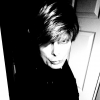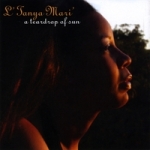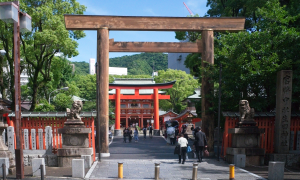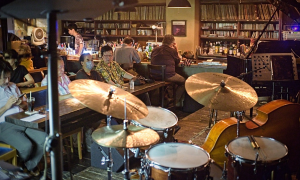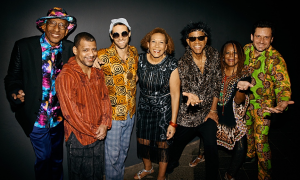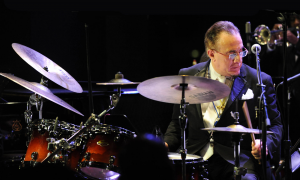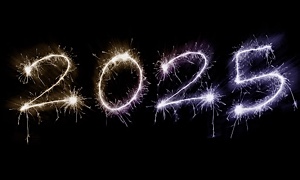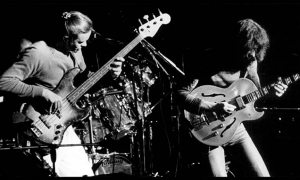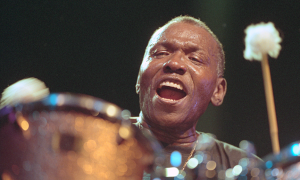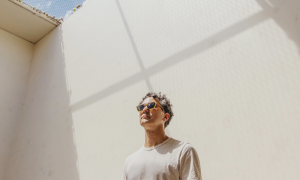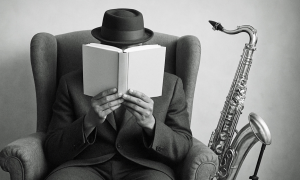Home » Jazz Articles » In the Artist's Own Words » Mark O'Leary: Plucking the Flower
Mark O'Leary: Plucking the Flower
The guitarist's encyclopedic interests and remarkable prolificacy are amongst the many subjects he covers in this latest installment of In The Artist's Own Words.
Beginning and Formative Influences
Mark O'Leary: I live in Cork, in the area of Turners Cross Douglas. When I was around seven or eight, I wanted to be a drummer. I used to play along with these shows on TV, on whatever was available and sounded good. I have an uncle who is a multi-instrumentalist that was involved in the show band scene in Ireland in the '60s, and my grandparents also had an upright piano in their house, so any time we visited I would spend hours at the piano just pulling out melodies. A year later, my brother began to play the guitar. I had no interest at that time, but at the age of 11, I began watching Top of the Pops and really started to get into what was happening at the time. I got a guitar from my uncle, and that was it. I actually started to use it as a bass and then as a lead guitar, as most of the strings were missing at that stage except the top three. I acquired the basic open chords from a neighbor and got the rest from the Complete Guitar Handbook. Some magazines as well—Down Beat, especially the old issues from the 1970s—were a source of inspiration. Later, imagination and determination took care of the rest.My early influences were Louis Stewart, an amazing guitarist from Ireland—a great player and a genius as well. I idolized him. And of course, Rory Gallagher, who came from the same neighborhood in my town, Cork. I spent hours copying his tunes when I was 12. I would put on the record of him and I would play along with it while my family were looking at me as a party piece. Later, I would get word that a guy across town had a tape of Mahavishnu Orchestra from the '70s and I was on my bike to check it out. I would try to figure out what John McLaughlin was doing and try to study the scales he was using. His swing lines, broken rhythms, chords, energy—it just inspired the hell out of me.
When I was 16, I was working with delay pedals as well and getting into soundscape material inspired by Terje Rypdal and Robert Fripp. Rypdal was probably the first guitarist I remember seeing on TV. For me, he is one of my most important influences. Even as a sideman, his playing on Edward Vesala's Satu (ECM, 1976) just amazed me; it still does. His use of delay with distortion opened my imagination. Fripp's layering was what attracted me, but it is also his intervallic approach which I found unique. I tried to work on that and move it somewhere else.
I loved John Abercrombie. His album, Timeless, (ECM, 1974) was just amazing. I also liked Philip Catherine quite a bit because of his sense of melody. To be honest, Bill Frisell is also an influence. I don't listen to him too much anymore because he is so copied, but I think he is superb, the way he can constantly reinvent himself. Pat Martino also inspired me, in terms of his long fluid lines and his energy. Martino's Live! (Muse, 1972) is still one of my favorites—hard to beat, for the idiom. Pat Metheny's Song X (ECM, 1985) is another serious influence. I could talk all day about that record. I also liked the darkness of Allan Holdsworth. He is a genius.
Ironically, when I started playing, the guitar I had was a little unstable and the bridge broke, so I used to elevate the strings with a battery. It sounded a lot like Derek Bailey, who later, I have to say, also became an influence. I had some Spontaneous Music Ensemble (SME) recordings, and he and Evan Parker influenced me quite a bit. Evan's angular, cut-off phrases and Derek's use of volume pedal—that influence is all over my work.
That's how I learned—totally autodidactic and idiosyncratic. I had to discover this myself, looking through record and tape collections, reading a review and getting the album. Several teachers at my high school were inspirational intellectual types who encouraged us to set high goals and go beyond ourselves. The scene here in Ireland was rock and pop-oriented, although jazz has a tradition all over Ireland, with a lot of incredible players—very modest, giving guys who never recorded or made careers for themselves, but gave so much to me and others. When I was in my late teens I played all over Ireland and ended up playing with most of them.
When I think back, I remember that the teachers every Friday would get up on stage without material and improvise—no structure, nothing written, just play. I found this amazing, and I ended up doing it a lot myself, but it was my first introduction to it and it inspired me quite a bit.
So I was there for a year, and when I returned to Ireland, that's where the major work began. I started to work as a teacher and I also discovered some very important music which I consider my strongest roots---Edward Vesala, Paul Bley, Tomasz Stańko and early Jan Garbarek. I liked his Triptykon (ECM, 1972). The austere melodies and rubato figures contoured my aesthetic. Vesala's stark melodies on Nan Madol (ECM, 1974), Satu (ECM, 1976) and Lumi (ECM, 1986), and the way the music evolved, the dynamic contrast, are really a music for the soul. It reached me and effected me deeply.
I love Stanko's early recordings. He is one of the great tone poets; Stanko always has a song in his heart. They, along with Stockhausen, Reich, Ligeti and later Anton Webern and Arnold Schoenberg really shaped who I am now. Even though I am always open and listening and learning from new music in all idioms, I would consider these artists of foremost importance to the shaping of my aesthetic as a composer and musician.
Selected Projects
My first band after that was with local guys here in Cork—guitar, drums and electric bass, called the Mark O'Leary Trio. We played a mix of standards, fusion and free material. It was like doing a Master's program. It was a lab, a canvas, an arena for developing, but also some innocent fun, because the music was far from perfect. When that band finished, I decided that I never wanted to call another band that name again, because the music was very special to me.The first project I did here was with Kenny Wheeler. I have always loved Kenny's playing and tunes, so I decided to bring him over to Cork for a concert project. It took some persuading, as I had no albums out and had not played outside Ireland or in the USA. Ironically, during rehearsals, he asked me if I composed anything for the concert. I hadn't, because I was putting everything I had into learning his music, but I started a few months afterward. I'm not the most confident person in the world, so the project with Kenny gave me the self-belief I needed to keep going. I am still very grateful to him.
Matthew Shipp, Mat Maneri and Randy Peterson
The first recording project I did where I didn't feel like had to genuflect all the time was when I recorded with Matthew Shipp and Mat Maneri. It was just after 9/11 and things were incredibly tense, but I love New York and had to go to show my support to family and friends. That was a really positive experience. "Out of this nettle danger, we pluck this flower, safety," as Shakespeare wrote.We played at Tonic and The Kennedy Center. Three records came from the project. Mat and I made a trio with Randy Peterson on drums for Self Luminous (Leo, 2005). Chamber Trio (Leo, 2005) is with Matthew and Mat, and the new Labyrinth (FMR, 2009), which is dedicated to writer Jorge Luis Borges, is a duo with Matthew, whose playing on it is very different and special—it's very impressionistic. During the sessions with Matthew, Mat and Randy, we discussed the direction of the music a little before we played, but nothing was composed—we just played.
In Chamber Trio, one thing that did capture our imaginations during the recording is our mutual appreciation of Charles Ives. I have always been a big fan of his sonatas for piano and violin. I think, for me, there are moments on that album where I can hear strains of it permeating the music. The labyrinthine impressionism of the duo disc lends to its title. It was very profound—for me one of my deepest, most emotional—when I listen to that disc, I am still very moved by it. I love Randy's drumming. He is unique; his rhythmic editing and dynamism are terrific. His playing was the critical element, in terms of how the music evolved and enhanced the interaction between guitar and viola. Also, Mat refrained, of his own volition, from using electric viola on both projects. I like the juxtaposition of electric and acoustic instruments.
Shamanic Voices
I heard one of Norwegian percussionist Terje Isungset's discs and got in touch with him. He came over for a tour of Ireland.Before we started, we recorded Shamanic Voices (FMR, 2007) at Studio Fiona in Fermoy. We spent the day recording, and Terje added some overdubs. I later added some ambient sounds and worked on producing the disc with engineer Jer Spillane.
I used a 12-string guitar tuned down to B and used various guitars, amps, effects and laptop. It's my Tubular Bells (Virgin, 1973) in a way.
Resources were limited; you have to rely on people skills. Jer, the engineer, is talented at getting the best out of people. I talked with Terje a lot before we even played a note together, and we had agreed that it's very easy for a project like this to slip into the folk idiom. I'm not really a folk player and I didn't want to have too much cheeky-chappy sentimentalism either, so I had to really dig deep to find an approach that could work.
The title was in the back of my mind for a long time. I did quite a bit of research into it. In Ireland, we have a mystical past with Tir na Nog and Cu Chullain, and the Norwegians are rich in mythology as well.
Zemlya
The sagas of Iceland are etched in my soul. In 2002, I went to play in Iceland, it was the most defining moment in my life. It changed my outlook, and developed my interest in performing electronic music. The great Icelandic drummer-improviser Matthias Hemstock mentioned I should check out viola player Eyvind Kang. Eyvind is half Icelandic—he even has a disc called The Story of Iceland (Tzadik, 2000)—and Iceland was so central to the project that I called a tune on the disc "Story of Iceland, Pt. 2." Zemlya means "land."When I did the project, I remembered this poem I heard at school years back, that a friend was reciting that totally inspired me, and as soon as I got to Seattle, I knew that was going to be the name of the project. Eyvind and Dylan van der Schyff are incredible people. Dylan is a great friend. You just got to love Canadians. Eyvind is an incredible artist. His knowledge of music is astounding, from Romanian spectral composers to Punk to David Sylvian to Beck.
Also, Seattle is an incredible city. I was into, and still am into, the spirit of Nirvana, Soundgarden and Grunge. The song "Kurt's Park" on Chamber Trio is a petit homage pour Cobain. But visually the panorama and atmosphere of Seattle are kind of hard to beat. No wonder so many great artists came from there. I stayed on Vashon Island for a few days with Eyvind, which was unique. We even spent time hanging out at a monastery with Russian Orthodox Monks, drinking coffee and learning about the rites and mysteries of Orthodox Christianity. We played at the now-defunct Polestar—an auspicious start. Things just kept getting better. On the last gig we played, I just remember looking at Dylan, and it was magic. We had not only become a band, but had grown as musicians also.
I still have more to do and learn, but it was a great little band, most definitely a development on Self Luminous, and on the recording some of those Viola-Guitar exchanges kind of evoke a neo Django Reinhardt-Stephane Grappelli nonchalance. Randall Dunn did a great job. He is a great recordist, him and his partner Mel, who run this great studio, Aleph.
On The Shore
I went to school in Los Angeles in the late-'80s and there was a deep desire to go back. I really admired Alex Cline. He is an incredibly eclectic drummer and a unique percussionist. What he has done for the improvised music scene in LA is very important. To have someone of his caliber domiciled and performing there has benefited the scene enormously. He has, like me, a deep affinity for all things Arvo Pärt, Vesala and Sigur Rós.I got the opportunity to do a project with Alex, and again it was a defining experience for me. I learned so much from staying at Alex's house, talking about music, approaches, listening to his record collection, and talking about different styles. It was very beneficial, and it came through in the project and has shaped who I have become. I have to thank Alex and his wife for everything in making the project happen. To say that I'm grateful is an understatement. Sometimes we can take things for granted in life and be unappreciative. I have come across a lot of selfless people who continuously give of themselves to make peoples' lives better and I am thankful for their sacrifices, for they are the ones who facilitate the dreams, hopes and desires of creative people; they are the true heroes.
I collected stones, sticks and shells from around Cork harbor and brought them to Los Angeles for Alex to use during the recording. You can hear these on "Dancing With the Wind," and the concept lent its name to the album title. I used some canonic ideas, some themes and sketches to direct the session. I was constantly running between the booths directing the session: "Let's try it this way, let's try to move the music in this direction now." You can't push too hard, but I had a vision with this project and you have to go for it. It was a great day. Jeff Kaiser and John Fumo are major doyens of the scene, and we played as two trios before recording, so we got to know each other musically.
The trumpets were incredible. "Voices From the Past" is another reflection of their melodic-harmonic cohesion. I think the spirit of Vesala is on the recording; Part and Giya Kancheli are there as well. There are a lot of great moments. It took time for it to crystallize, but when we got there, it was a special moment. I sent it to Pedro Costa at Clean Feed, and he was not sure. He actually said no, but then came back to me and said he was going to take it on holiday with him and think it over. He sent me a mail a month later and said he wanted to put it out. It took a year till it was released, but it's a great disc and I appreciate him for doing that.
The Synth Show
I played opposite Kenny Wollesen in Munich when I played there with Paul Bley, and we decided to play sometime. So we kept in touch, and when the time came, I asked Jamie Saft if he would join us. We connected in New York. It's a nice recording.The Synth Show (Leo, 2008) concept started to sink in more after the recording in post production. I saw a show on BBC about the Radiophonic workshop, and some of the innovative sounds from Delia Derbyshire influenced me a little bit. I liked synth music by Klaus Schultze, Rick Wakeman, Joe Zawinul, Jean Michel Jarre, Jan Hammer, and Tangerine Dream, which captured everybody's imagination in High School. The Synth Show is raw and energetic, back to the '70s.
We recorded in Jamie Saft's Frank Booth studio in Brooklyn. I created the soundscapes in Cork later and put it all together. Some of it is very prog-oriented. There is melodic material there also, as well as some atmospherics and some jam fusion called "Texas." The tune for film director Ingmar Bergman has a really nice intro from Kenny with some lush synth pads from Jamie, and I'm using e-bow and delay. That was an exceptional moment for me in all of my work.
Artistic Goals
Many of the people I play with are not household names. They are not known outside of their locality, but they are excellent. What counts for me is that you are practicing, developing, learning as an artist, composing and fronting your own band, trying to do something new and adding to what's gone before respectfully. This is my philosophy. I'm ambitious, positive and hard-working, and I like to play with like-minded people from wherever they may emanate. Jealousy can be a very positive force. It can drive you to do things, to achieve, but I don't like negative, cynical, lazy, loader, team-up types.I also want to produce contrasting discs that have a concept that people can buy into, not just getting up on stage and letting rip. For me, that's over. What's important now is to capture people's imagination, not idealistically but conceptually. I left that to my fellow countrymen Bono (and I love U2) and Bob Geldof. I am artistically centered, but I do want to play the major festivals and I send the e-mails out and make calls myself. I practice, teach, compose, play and when I have free time, I do this work.
I don't play golf, drive or go out much either; I practice, compose, listen, learn all the time. I love it; I live it. It's tough—you have to really push. Also, some festivals and countries just won't give you a chance. It's a closed shop sometimes. I really do think I am David against this Goliath situation, but it does not deter me. It is unfair, but just because life is unjust, it should not dissuade you from pursuing your goals. You can't just sit back and reach for your pipe and slippers, not just yet anyway!
Future Plans
My Television (Ayler, 2008) disc, with Han Bennink, was just released. Han, for me, if you want to talk about drummers, is one of the best drummers in the world. Playing with him can be heavy. He can play anything and play on anything. He is also a performer and does circus tricks and magic. If you don't have a few white rabbits yourself, it can be very embarrassing.I played in Belgium last year with Stephane Galland and Michel Hatzigeorgiu from AKA Moon, and that was an incredible opportunity. We recorded a really nice live disc. Hopefully, I will be able to release it at some point and play with them again.
I worked with some very talented musicians and artists in Istanbul recently, and we recorded three great discs. Taking a ferry trip across the Bosporus, the scent of the air from the Black Sea juxtaposed with aroma of the bazaar, East meets West, where ancient and modern intertwine, a melting pot of cultures at the crossroads of the world.
Wading through snow in Sarajevo, next day basking in the sun in Podgorica, playing some of the hottest fusion on earth with Vasil Hadzimanov and Marko Djordevic in Belgrade, Subotica and Pavorotti centre in Mostar.
Selected Discography
- Mark O'Leary, Ode to Albert Ayler (Ayler, 2009)
- Mark O'Leary, Labyrinth (FMR, 2009)
- Mark O'Leary, St Fin Barres (Leo, 2008)
- Mark O'Leary, The League of Xtraordinary Gentlemen (Re:konstruKt, 2008)
- Mark O'Leary, The Synth Show (Leo, 2008)
- Mark O'Leary, Fabrikraum (Creative Sources,2008)
- Mark O'Leary, Ellipses (FMR records 2008)
- Mark O'Leary, Zemlya (Leo, 2008)
- Mark O'Leary, Television (Ayler, 2008)
- Mark O'Leary, Flux (FMR, 2008)
- Mark O'Leary, Shamanic Voices (FMR, 2007)
- Mark O'Leary, Signs (FMR, 2007)
- Mark O'Leary, Skyshifter (Creative Sources, 2007)
- Mark O'Leary, White Night Festival (Kadima, 2007)
- Mark O'Leary, Waiting (Leo, 2007)
- Mark O'Leary, Radio Free Europa (Leo, 2007)
- Mark O'Leary, On the Shore (Clean Feed, 2007)
- Mark O'Leary, Awakening (Leo, 2006)
- Mark O'Leary, Chamber Trio (Leo, 2005)
- Mark O'Leary, Self-Luminous (Leo, 2005)
- Mark O'Leary, Levitation (Leo, 2005)
- Mark O'Leary, Closure (Leo, 2005)
Tags
Mark O'Leary
In the Artist's Own Words
Eyal Hareuveni
Louis Stewart
Rory Gallagher
Mahavishnu Orchestra
john mclaughlin
Terje Rypdal
Robert Fripp
John Abercrombie
Philip Catherine
Bill Frisell
Pat Martino
pat metheny
Allan Holdsworth
Derek Bailey
evan parker
Ornette Coleman
Paul Bley
tomasz stanko
Jan Garbarek
Kenny Wheeler
Matthew Shipp
Mat Maneri
Django Reinhardt
Stephane Grappelli
Alex Cline
Jeff Kaiser
John Fumo
Kenny Wollesen
Joe Zawinul
Jan Hammer
Han Bennink
PREVIOUS / NEXT
Support All About Jazz
 All About Jazz has been a pillar of jazz since 1995, championing it as an art form and, more importantly, supporting the musicians who make it. Our enduring commitment has made "AAJ" one of the most culturally important websites of its kind, read by hundreds of thousands of fans, musicians and industry figures every month.
All About Jazz has been a pillar of jazz since 1995, championing it as an art form and, more importantly, supporting the musicians who make it. Our enduring commitment has made "AAJ" one of the most culturally important websites of its kind, read by hundreds of thousands of fans, musicians and industry figures every month.


